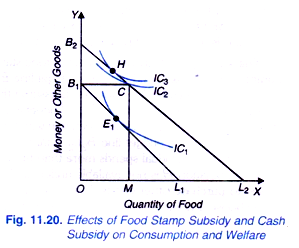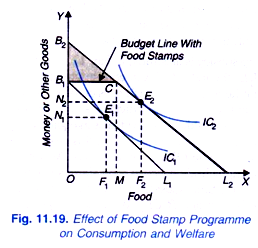Food stamp programme is a type of food subsidy to provide poor people with adequate quantity of food.
It is a form of in-kind food subsidy in contrast to the subsidy provided in the form of cash income, often called cash subsidy. In the United States it was introduced in 1964 and was amended in 1979 and since then it continues there in the amended form.
In India also food stamp programme has been suggested in recent years as an anti-poverty measure.
Under food stamp programme, some stamps or coupons are given to the eligible persons or households. With these stamps, the recipient can buy food and only food. That is, these food stamps cannot be used to buy non-food goods. Further, these stamps cannot be traded or transferred to the other people.
ADVERTISEMENTS:
Let us explain how a receipt of food stamps affects the budget line, consumption of food and welfare of the individual. We will also demonstrate how the effect of food stamp subsidy differs from cash subsidy. Consider Fig. 11.19 where along the X-axis we measure quantity of food and along the Y-axis we measure money which represents all other goods, (i.e. goods other than food).
With a given income of an individual and given market price of food, B1L1 is the budget line whose slope represents the price of food (Note that price of money represented on the Y-axis is Re. 1, that is, price of rupee one is Re. 1.). OB1, is the given money income of the individual. Before the receipt of food stamps the individual is in equilibrium at point E1 on indifference curve IC1, and is consuming OF1, quantity of food and ON1 quantity of other goods per week.
Now, suppose the individual is given food stamps of Rs. 200 per week, which he can spend on food alone. Suppose further that price of food is Rs. 10 per kg. With stamps of Rs. 200 he can therefore buy 20 kg of food. Since the consumer cannot use food stamps to buy non-food items (other goods), he cannot spend more than his initial income OB1, on other goods.
ADVERTISEMENTS:
Thus above the horizontal line B1C, the combinations of other goods and food are not attainable when he is given food stamps of Rs. 200. Suppose at the given market price of food, he can buy B1C amount of food with the food stamps of Rs. 200 provided to him, while spending his entire income OB1 on other goods.
For instance, if price of food is Rs. 10 per kg., then with Rs. 200 he can buy 20 kg of food. In this case, therefore, B1C will be equal to 20 kg. If the individual wants to buy more food-grains than B1C, then he will spend some part of his initial income to purchase additional food. Since the food stamps are in addition to his initial income OB1 his budget line with food stamps becomes a kinked line B1CL2.
The food stamp programme can affect the recipient in two ways. One possibility is that with the food-stamp subsidy and resultant kinked budget line B1CL2, in Fig. 11.19 the individual maximises his satisfaction at point E2 where his budget line is tangent to indifference curve IC2. At this new equilibrium point E2 he is purchasing OF2 quantity of food and ON2 of other goods. Thus, as compared to the situation prior to food-stamp subsidy, he is on higher indifference curve showing a greater level of satisfaction or welfare and consuming greater quantities of food and other goods. Thus, food stamp subsidy has led him to buy not only more food but also more of other goods. This means that food stamp subsidy has been indirectly used for financing the purchases of non-food commodities.
It is important to note that in this possible case, the effect of food stamp subsidy is exactly the same as would be the case if cash subsidy is granted to the individual. Thus, if instead of food stamps the individual is given cash income of B1B2 (Note that with given market price of food, cash income of B1B2 can buy B1C quantity of food and thus the two are equivalent), the budget line will shift from B1L1 to B2L2.
ADVERTISEMENTS:
But given the preferences of the individual between food and other goods, he is in equilibrium at the same point E2 at which his budget line B2L2 is tangent to the indifference curve IC2. Thus, in this possibility, the effect of equivalent cash subsidy is exactly the same as the effect of food stamp subsidy. This happens because the preferences of the individual between food and other commodities are such that he wants to have more than B1C quantity of food which is the quantity of food provided under the food stamp subsidy.
Another important conclusion from this possible case is that with either food stamp subsidy or cash subsidy the individual buys more of both food and other goods than he buys before the grant of subsidy. This is because food and other goods are here considered as normal goods whose quantity demanded increase with the increase in income.
The second possibility of the effect of food stamp subsidy is illustrated in Fig. 11.20. Prior to grant of any subsidy, and given his budget line B1L1 the individual is in equilibrium at point E1 on indifference curve IC1. Now let us assume that he is given the cash subsidy of B1B2 so that with the given market price of food, budget line shifts to B2L2.

With equivalent food stamp subsidy of B1C, the individual has to choose a point which must be on the kinked budget line B1CL2. With the budget line B1CL2 with food stamp subsidy, the best that the individual can do is to choose the comer point C of budget line B1CL2 which lies on the highest possible indifference curve IC2 passing through the point C.
Therefore, from the point of individual welfare we reach our earlier conclusion that cash subsidy is superior to in-kind subsidy represented by food stamps programme. This is because cash subsidy does not limit a person that he must purchase a certain amount of food and he is therefore free to spend as he likes.
But it should be noted that the consumption of food in case of cash subsidy is less than under the food stamp subsidy programme. If the purpose is to increase the consumption of food and therefore provide adequate diet to the people, then food stamp subsidy is better than cash subsidy as under the former, the individual is constrained to buy at least a given quantity of food.
Another important result obtained from our above analysis is that even with food stamps programme the individual increases the consumption of all other goods (i.e., non-food items) too. This shows that a part of food stamp subsidy is indirectly used to finance the increased consumption of other goods. This is because some part of the income which the individual was spending on food prior to food stamp subsidy get released because of the food stamps being used for its purchase and this released income is spent on non-food items.
This increases the consumption of non-food items also. This result is of special importance because supporters of food stamp subsidy have been emphasising that food subsidy should not be used to finance any part of non-food unnecessary items such as liquor. However, as seen above, in practice it is difficult to make a plan that will increase the consumption of subsidised food and will not affect the consumption of other goods.
ADVERTISEMENTS:
Lastly, out of the two possibilities of the effects of food stamp subsidy and cash subsidy which is the most common result, that is, the most common outcome of the two possible cases presented in Fig. 11.19 and Fig. 11.20. However, the final result of the two types of subsidies depends on the value of food stamps relative to preferences and incomes of the individuals whom subsidies are granted.
We cannot predict the specific result purely on theoretical grounds. Empirical research conducted in the USA however reveals that most recipients of food stamps programme represent situation depicted in Fig. 11.20. This means for most of the recipients, food stamp programme has the same effect as a cash subsidy.
